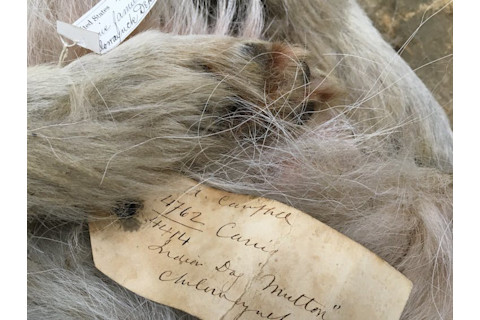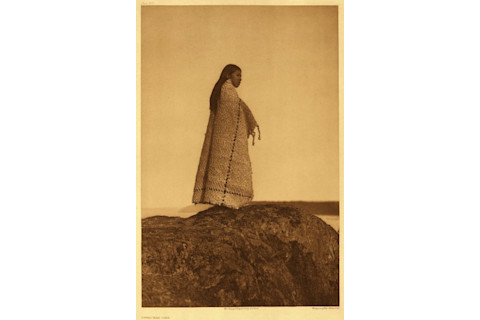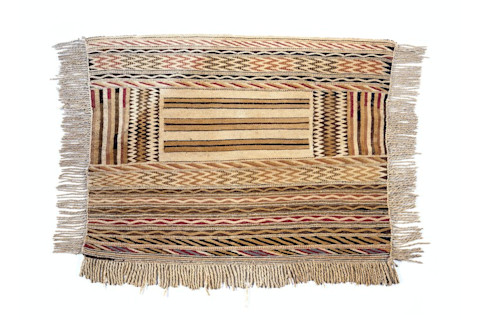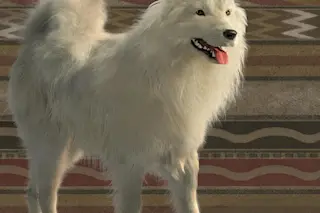Dogs have been in the Americas for more than 10,000 years. They were already domesticated when they came from Eurasia with the first people to reach North America. In the coastal parts of present-day Washington state and southwestern British Columbia, archaeologists have found dog remains dating back as far as about 5,000 years ago.
Dogs performed many different roles in North American Indigenous communities, including transportation, that in other parts of the world were done by multiple other domestic animals.
Prior to the arrival of Europeans, the Indigenous Coast Salish peoples of the Pacific Northwest had traditionally maintained a breed of long-haired dog for the purpose of harvesting their hair, or wool, for textile fibers. Along with alpacas and llamas, these woolly dogs are one of only a few known animals intentionally bred for their fleece in all of the Americas.
But the practice of keeping woolly dogs and weaving textiles made from woolly dog yarn declined throughout the 19th century, and the dogs were considered extinct by the beginning of the 20th century. What had happened to them?

(Credit: Audrey Lin) Mutton’s pelt has been preserved at the Smithsonian Institution for more than 160 years.
Audrey Lin
Today, the only confirmed woolly dog specimen is “Mutton,” whose pelt has been housed in the Smithsonian’s collection since his death in 1859. In life, this “Indian dog” was the companion of George Gibbs, a naturalist working on the Northwest Boundary Survey expedition to map out British Columbia and the American Pacific Northwest. In death, Mutton offered the opportunity to learn more about woolly dog ancestry, selection and management.
We are an archaeologist, an evolutionary molecular biologist and a molecular anthropologist who are part of a large research team. It’s important to note that although we collaborated with a number of Indigenous people on our study, the scientists, including the three of us, are not Indigenous. Alongside historical documents and interviews of Coast Salish elders, knowledge keepers, weavers and artists, our team utilized “Two-Eyed Seeing” – viewing the world through the combined strengths of Indigenous knowledge and western science – to bring Mutton’s story and legacy back to life.
A prestigious part of Indigenous culture
Prior to the arrival of Europeans, there were several types of dogs in the Pacific Northwest: larger “village” dogs and hunting dogs and smaller woolly dogs, kept separately to prevent interbreeding. Woolly dogs were a little larger than the modern American Eskimo dog breed and had curled tails, pricked ears and a pointed foxlike face. Instead of barking, they howled.

(Credit: Edward S. Curtis, 'The North American Indian,' 1912/Wikimedia Commons) A young Cowichan woman wearing a woven blanket in the early 1900s.
Edward S. Curtis, 'The North American Indian,' 1912/Wikimedia Commons
Traditionally, only high-status Coast Salish women were allowed to keep woolly dogs, and a woman’s individual wealth could be measured by how many she had. Blankets woven of dog hair, often mixed with hair from mountain goats and waterfowl or plant fibers, were important trade and gift items.
Historians and economists, looking back, first claimed the disappearance of the woolly dog breed was the result of simple capitalist forces: The availability of cheap manufactured blankets offered by businesses like the Hudson’s Bay Company meant the Coast Salish didn’t need to make their own blankets. Why go through the immense time and labor in keeping wool dogs and crafting blankets in the traditional way when you could just buy a machine-woven blanket?
But the Coast Salish don’t agree. Debra qwasen Sparrow, a master weaver of the Musqueam Nation, explained to us, “The blankets really tell a story of our history, our families, the way in which they identified in the communities, (they’re) all reflected in the blankets.”
And Coast Salish people say they would never have willingly parted with their beloved canine friends. The simple economic explanation ignores the massive role colonialism played in the demise of the woolly dogs. Repressive government policies tried to control and subdue Indigenous cultural practices.
“They were told they couldn’t do their cultural things. There was the police, the Indian agent and the priests,” Stó:lō Nation elder Xweliqwiya Rena Point Bolton told our research team. “The dogs were not allowed. (My grandmother) had to get rid of the dogs. And so the family never ever saw them.”
Eventually, there were no more Coast Salish woolly dogs.

(Credit: Audrey Lin) Researchers used a portable X-ray fluorescence analyzer as part of their investigation of Mutton’s remains.
Audrey Lin
Piecing together a picture of Mutton’s life
We did have access to Mutton’s pelt, though, which had been archived for more than 160 years. No one knows exactly how Gibbs initially acquired Mutton, but it’s likely he got the dog while working with local communities in Stó:lō territory in present-day British Columbia. Using modern techniques, we set out to answer questions about Mutton’s breed and ancestry.
First we used stable isotope analysis, a chemical analysis of once-living tissues, to understand more about Mutton’s environment when he was alive: what kinds of foods he ate and the state of his health.
Interviews of the elders and knowledge keepers confirmed that the woolly dog diet was very different from village dogs, including special foods that kept the dogs healthy and their coats shiny. For example, salmon, elk or certain local plants would be set aside for the woolly dogs.
The stable isotope values of Mutton’s fur suggested he’d been eating maize for some time, but less and less up to the point when he died. The letters of one expedition member imply they were running low on cornmeal and supplementing their imported supplies by trading with locals. Although Gibbs noted in his journal that Mutton was ill before he died, there was no isotopic evidence to support chronic illness; Mutton may have become sick quickly.

(Credit: Hsiao-Lei Liu) Chris Stantis carefully removes a minimal sample from Mutton’s pelt for further analyses.
Hsiao-Lei Liu
Next, we turned to genetic analysis for insight into the dog’s ancestry to understand long-term management of this breed. We sequenced Mutton’s DNA and compared it with a contemporaneous village dog that was killed by the explorers in an unknown village in the Pacific Northwest. We also compared Mutton’s DNA with a genetic panel of many other modern and ancient dogs.
We found that Mutton is a rare example of an Indigenous North American dog with precolonial ancestry who lived well after the arrival of white settlers. Using a dataset of mitochondrial genomes from Mutton and more than 200 ancient and modern dogs, we made an elaborate family tree. Called a time-calibrated phylogenetic tree, it creates a diagram of the evolution of Mutton’s maternal lineage.
Based on the tree, we estimate that Mutton’s most recent common ancestor diverged from one other ancient dog from British Columbia between 1,800 and 4,800 years ago, corresponding with the known archaeological record. In other words, Mutton’s woolly dog lineage has been isolated from other dogs for millennia.
We see evidence of inbreeding in Mutton’s genome that can result only from careful long-term selective breed management. We identified variants of genes associated with hair and skin, including KRT77 and KANK2, which are linked to woolly hair in humans.
However, Mutton lived during a very volatile time period. For example, in 1858 more than 33,000 miners flooded into present-day British Columbia in search of gold. This influx left its mark in Mutton’s DNA, and we found that about one eighth of his genome – representating about one great-grandparent’s worth of DNA – came from settler-introduced European dogs.
Finally, we worked closely with a scientific artist, using archaeological dog bones and Mutton’s pelt, to reconstruct what these dogs looked like in life with scientific accuracy.

(Credit: USNM E2124, Smithsonian National Museum of Natural History) A Coast Salish classic-style blanket, which has woolly dog hair in the warp fibers that were stretched across the loom. Accessioned 1838-1842.
USNM E2124, Smithsonian National Museum of Natural History
What this woolly dog confirms about the past
With Mutton’s pelt, our team wove together these different ways of exploring the many lives of Mutton – his ancestry as an Indigenous dog, his life traveling with white settlers, and finally his time in the Smithsonian Institution.
Mutton is the latest dog we’re aware of with that much precolonial dog ancestry. European colonization was devastating to Indigenous people in North America. The fact that Mutton carries as much Indigenous dog DNA as he does is a testament to the care that Coast Salish people took to keep the woolly dog tradition alive.
Our Coast Salish weaving collaborators are very keen to learn more about how traditional blankets housed in museum collections are made – to inform efforts to revive complex techniques and better understand the unique materials used. With Mutton’s genetic sequencing, future researchers may be able to identify dog hair in heritage woven materials. Some Coast Salish would like to see the woolly dogs return to their families once again. There’s currently no way to bring back the original woolly dogs, such as by cloning Mutton, because his DNA is far too degraded after more than 160 years. But a new kind of woolly dog could be created in the future through selective breeding and care.
“But the thing that’s most important (is) that (the) wool dog created a gift to produce and to make something, to create something, to bring something alive,” Michael Pavel, elder of the Twana/Skokomish Tribe, told us. “Let’s do that. Let’s bring that back to life. … The wool dog is still very much a part of our life.”
Audrey T. Lin is a Research Associate in Anthropology at the Smithsonian Institution. Chris Stantis is a Postdoctoral Research Fellow in Geology and Geophysics at the University of Utah. Logan Kistler is a Curator of Archaeobotany and Archaeogenomics at the National Museum of Natural History at the Smithsonian Institution. This article is republished from The Conversation under a Creative Commons license. Read the original article.














